Setting the Stage for Outdoor Math Experiences
posted by Diann Gano
 As I look around me I see busy, happy children. Avery, Linnea and Anderson are busy seeing how high they can stack their rocks. Maya and Noa are near the sandbox creating a tea party for fairies, while Rowan and Parker are creating homes and meals for the squirrels over in the rain garden. It is calm. Everyone is happy and learning. We call this a play buzz.
As I look around me I see busy, happy children. Avery, Linnea and Anderson are busy seeing how high they can stack their rocks. Maya and Noa are near the sandbox creating a tea party for fairies, while Rowan and Parker are creating homes and meals for the squirrels over in the rain garden. It is calm. Everyone is happy and learning. We call this a play buzz.
When I stop and take a closer look, I recognize that not only is everyone happily playing, they are all working on math. M A T H! Did you know that nearly half of all children’s play involves math? (Seo and Ginsburg, 2004). The latest research also shows that early math skills are a better predictor of academic success than early reading skills! So here at the Gingko Tree, we are creating even more opportunities to introduce math concepts and problem-solving through play. As a family childcare with a Nature Explore Certified Outdoor Classroom, we spend a great majority of our time outdoors.
The environment IS our curriculum. When we add natural elements to their areas of play, it leads to playing in math-rich environments while creating and problem-solving in very deep and complex ways. As more and more classrooms and families are returning to the outdoors, simply giving our children the gift of time will lead them to mathematical play. It comes very easily to them without worksheets or number cards or dreaded memorization that may not be developmentally correct for where their brain development is at this time. As spring arrives, take this opportunity to create math-rich environments in your own backyard or play space. The only thing you can do wrong is not to do it! Bringing math into your outdoor or indoor environment is easy and even better it’s often free! In outdoor classrooms or family backyards, educators and parents are learning the beauty of loose parts in children’s learning and play experiences.
Architect Simon Nicholson, first proposed loose parts back in the 1970’s. Nicholson believed that we are all creative and that loose parts in our environment increase and empower that freedom to create. Loose parts are materials that can be moved, carried, combined, redesigned, lined up and taken apart and put back together in multiple ways. They are materials with no specific set of directions that can be used alone or combined with other materials. (Kabel, 2010)
We like to think of loose parts as shells, rocks, sticks, acorns, feathers, pinecones, flowers, flower petals, material, water, sand, dirt, moss, leaves, bark, rocks, pebbles, pine needles, seeds and else whatever may be native to your region. We also use blocks, people, animals and other manipulatives. Loose parts can range from dramatic play props to play cars, pots, pans, and pouring devices. If your environment doesn’t already contain those things, bring it in. If you have those, take them out! We rarely take walks without bringing home all kinds of the loose parts or “treasures” listed above. Use what you have. If it’s little, and your child hoards them in containers just to carry around and create “things” with; your child is playing with loose parts! Take advantage of what you have around you. Those are your tools for setting up a math rich environment. Let’s get started!
Storage is an important part of loose parts because it gives a sense of order and allows children access and knowing where those materials are. Indoors, I try to keep our natural loose parts materials in wood bowls, sturdy baskets, or other natural containers that look nice and add calmness to my environment. Outdoors we have used galvanized buckets, plant containers, crates, or any container source that we have nearby. Use your imagination. I can tell you from practice, the happier the container makes you, the more relaxed you will be with loose parts. Also, be aware that buckets and baskets may get dumped from what you are “storing” to become a piece of their loose parts puzzle. That’s a struggle for me. Usually, it means I need more containers for them to carry around or create with. The beauty of loose parts is that they can be moved, and so the child has power to create new adventures every day. Storage and carrying pieces are an important piece of the puzzle.
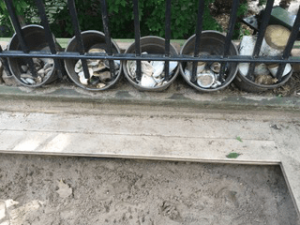
I recycled our spring planting containers. These worked out well, and were free! Win, win! We have these next to our sandbox. They are full of rocks, shells, bark, and birch branches today. We change our materials often. By “locking” these in under the fence, it kept them permanently placed without getting dumped.
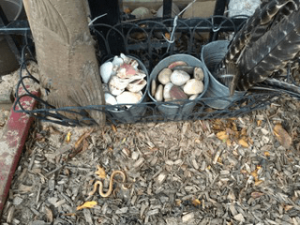
We have galvanized buckets in a wire window box. You can find galvanized buckets at IKEA, Farm Stores, and Amazon.
As more and more of your outdoors space becomes filled with natural materials and less plastic and branded play toys, you will see your child’s play change. It will become deeper, more focused and more creative. Trust me. It’s amazing.
Now we can bring in the materials! Do you have rocks nearby? Take a walk. You will find some. We have found some very pretty river rocks at the Dollar Tree. If you take a vacation, the rocks in different regions are often different colors, shapes, and textures. Add those to your collection. We love rocks and they often come home in pockets and backpacks.
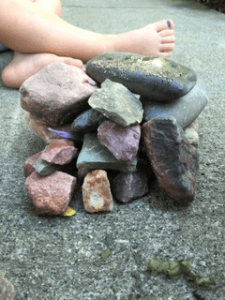
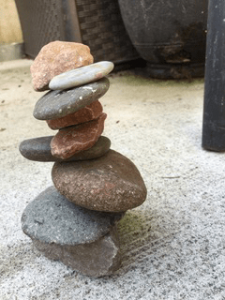
We play with rocks a lot. They line them up; they stack them up. They sort them by color, size, and texture. All of that is early math. They use them for food and phones and building. They rarely throw them. Honest. Call them your math rocks. There are throwing rocks and math rocks, and we only have math rocks.
Find some shells. Goodwill, Salvation Army, and garage sales have been our gold mines for shells. Any found on your own are even better because there is a story and memory behind it.
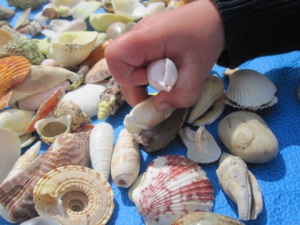
Bring in small tree branch slices, driftwood, bark or small twigs. We’ve used all of them. Pinecones, acorns, buckeyes will all add new discoveries and wonder to your math center. Children are full of math vocabulary, more or less, bigger or smaller, fair or equal. Loose parts will add this vocabulary into your child’s world on a daily basis.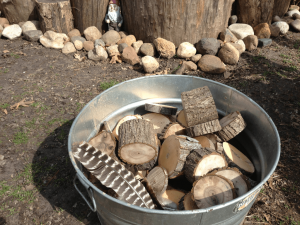
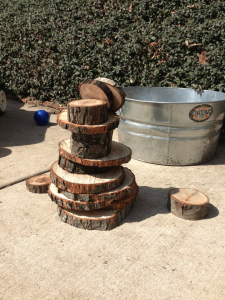
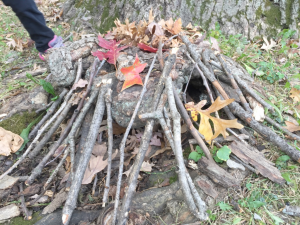
It’s a squirrel trap. You already knew that, didn’t you? It’s also logical thinking, creative problem solving, measuring length and size, comparing and estimation. Whew! That’s a lot of math in a squirrel trap built by a group of kids under the age of 5. This is where that gift of long, uninterrupted time is so important. Fifteen-minute recesses are not enough. Give them time.
If you want to learn more or see great examples of loose parts, I highly recommend looking at Dr. Carla Gull’s Facebook page, Loose Parts Play. She has great ideas on there, and contributors from around the world!
We love, love our mancala boards. 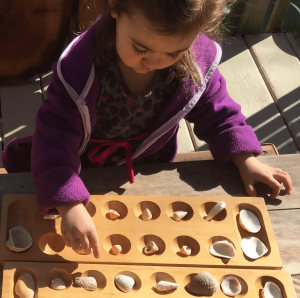 We use them with shells, stones, seeds, and pretty glitter marbled stones. You could use egg cartons or ice-cube trays, also. These are perfect for one to one correlation for teaching numeration. You won’t need to mention that of course. They will play with them where they are developmentally at that moment. It will all come. You are setting the stage to make it come so very easily, through play.
We use them with shells, stones, seeds, and pretty glitter marbled stones. You could use egg cartons or ice-cube trays, also. These are perfect for one to one correlation for teaching numeration. You won’t need to mention that of course. They will play with them where they are developmentally at that moment. It will all come. You are setting the stage to make it come so very easily, through play.
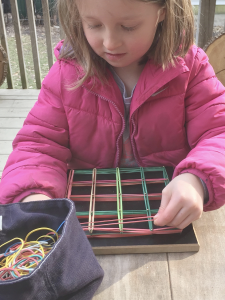 We also use our geoboards a lot. Besides all the geometric shape experiences they create, this also works the small muscle development and fine motor skills they will need when it is time to start writing. It may not look like math to them, but we know better!
We also use our geoboards a lot. Besides all the geometric shape experiences they create, this also works the small muscle development and fine motor skills they will need when it is time to start writing. It may not look like math to them, but we know better!
This is a “family” of leaves. It started innocently enough with a Daddy leaf and the play took off from there. Children are exposed to math vocabulary anytime size or comparison is involved. All these experiences are building blocks for early math development.
When four-year-old Gabe, discovered that the oak leaf was torn like the number three, it set off a flurry of creating numbers. We captured it on clear contact paper to admire and share with parents.
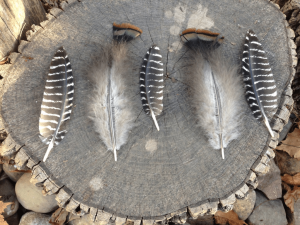
Math is all around us. Creating a math environment into your children’s play assures your child of future academic success. Including loose parts into your play area will create a learning environment that your child will be drawn to effortlessly. They will be learning. If you thought you needed worksheets or flashcards or screen time to prepare your child for school, I hope you will give this a try. You will be excited about the learning your child is experiencing. You will see it. They won’t. They will think they are playing. Which is just what we want our children to be doing. If you build it, they will learn. It will be fun for both of you! Go play!

I love this! It combines Math with Science. It\’s very open-ended and allows opportunities for individual learning experiences
This is really a great idea about outdoor play, you can use many tools like rocks and other nature things as you teach math.
This outdoor environment is so beautiful. Keep reading for the rest of the month to see some more fabulous pictures of the outdoors and children.
My favorite materials to use are found items suchas rocks, sticks, stones, caps, etc because they are inexpensive, versatile, and can be used for so many different activities!
It is wonderful how much math you can have outside for children. There is so math in the sandbox, riding the bikes, (how many times around, how long does it take you to go around. How many scoops to fill your dumptruck? Which bucket holds more?
Great idea! There is gross motor work, fine motor work, math, science and lots of rich language. Can’t wait to try out this idea.
Having taught kindergarten for 30 years, I’ve seen the beauty and magic of loose parts play. Sadly, that extended time of interrupted play is interrupted all day with the forever transitioning schedule filled with programmed curriculum. I’m excited to have a young grandson that I can create a rich and engaging environment for, both indoors and out. Thank you for continuing to inspire us with such deep and authentic learning ideas.